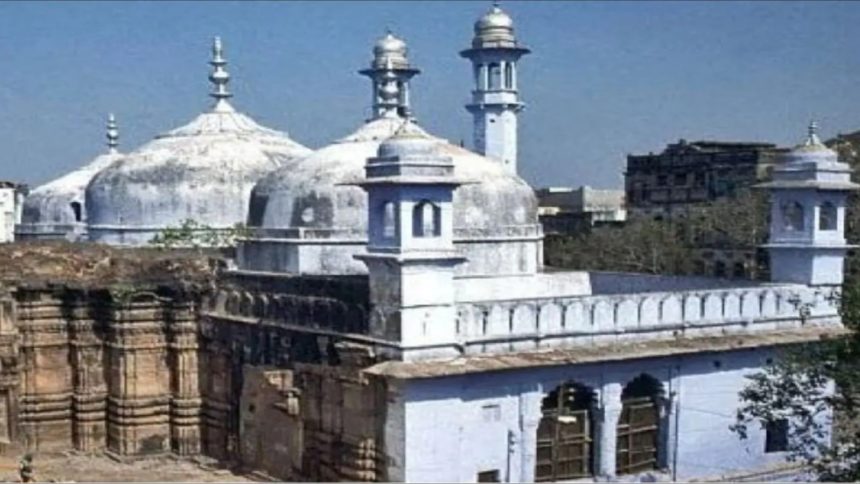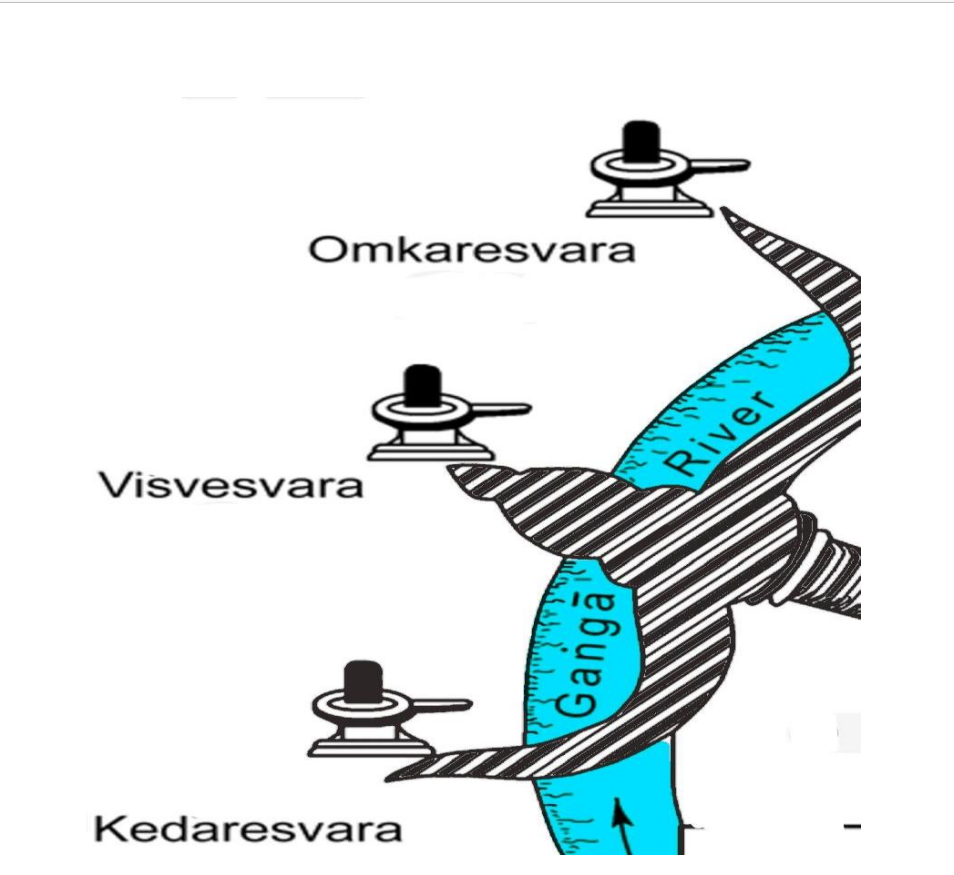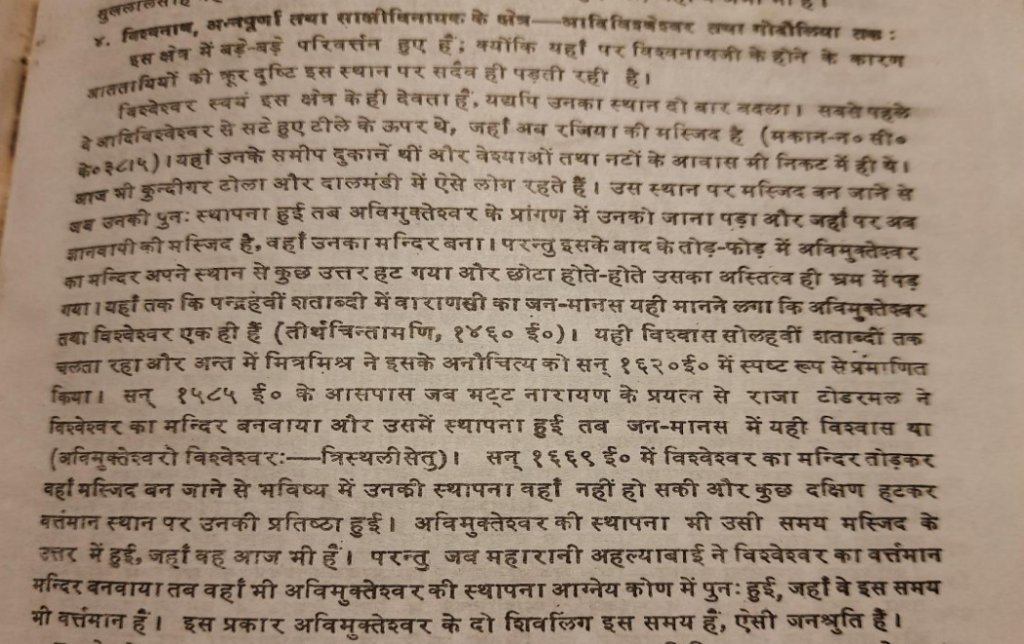The Gyanwapi Mosque is the original ancient site of Avimukteswara Linga and not the Visvesvara Jyotirlinga (Kashi Vishwanath). The fundamental factual inaccuracies and misconceptions with regard to the Visvesvara Jyotirlinga cast a cloud on the legitimacy of the otherwise legitimate Hindu claim on Kashi Vishwanath, and the grave errors render all flawed court petitions and prayers void ab initio.
The Misconception About The Antiquity And Location Of The First Original Site Of Visveswara Jyotirlinga (Kashi Vishwanath)

INTRODUCTION
There is absolutely no doubt that Hindus (Sanatana dharmis) have a legitimate, legally valid, morally justified, historically validated & spiritually enforced fundamental right to stake their claim on KASHI VISHWANATH but, unfortunately, the parties, individuals & advocates spearheading the crusade on this matter are totally ignorant about the correct facts of this matter and as such their court petitions/pleadings & media statements on this matter are riddled with innumerable factual flaws from shastriya, historical, archaeological as well as legal perspectives.
These fundamental flaws & misconceptions cast a cloud on the legitimacy of the otherwise legitimate Hindu claim on Kashi Vishwanath and the grave errors render all flawed court petitions and prayers void ab initio. It is not only shivadroha (sacrilege against Lord Shiva) but, a body blow to Sanatana dharma as well.
Further, if the Hon’ble courts rule in favor of the Hindus – the anti-national elements lurking in the shadows will surely highlight these lacunae and instill doubts in the minds of the Muslims. It is likely that they will spread confusion & rumors that grave injustice has been done to Muslims in India and unjustifiably claim that the right-wing fascist Hindu Government in India is anti-Muslim & that even the Courts have deprived Muslims of their fundamental rights. Moreover, the flaws, errors & omissions will leave the Hindus dissatisfied too. Undoubtedly, the consequences of this simmering social discontent & boiling communal cauldron will be disastrous for the law and order situation in the country.
Thus, it is extremely important to immediately revise all court petitions and ensure factual accuracy & legal correctness in this matter, and also understand that although Hindus have a legally valid & already-proven justified claim on Kashi Vishwanath – the need of the hour is to resolve this matter through a peaceful out-of-court settlement and check all possibilities of the ensuing communal violence.
FACTUAL FLAWS, HIMALAYAN BLUNDERS & THE REAL TRUTH
I have carefully noted the flawed and misleading statements made by the petitioners, advocates, scholars, religious leaders, politicians, and media on the Gyanvapi / Kashi Vishwanath matter. The real truth about these issues from shastriya/dharmic, historical, archaeological & legal perspectives are as under:
(1) THE VISVESVARA AND AVIMUKTESVARA LINGAS: As per Puranic & historical references Visvesvara (विश्वेश्वर) and Avimuktesvara (अविमुक्तेश्वर) are not the same but, are two different shivalingas. Both are sacred & swayambhu (self-manifested) and it is said that both were consecrated by Lord Shiva Himself but, Visvesvara is the jyotirlinga in which Shiva merged Himself.
Avimuktesvara is temporally older than Visvesvara and thus, Avimuktesvara was called ‘Adilinga’ and ‘Guru of Visvesvara’ but, Visvesvara is a jyotirlinga [one of the 12 famed dvadasa jyotirlingas] and the importance of Avimuktesvara is secondary to Visvesvara.
Visvesvara jyotirlinga is the ‘linga of all linga’ and is the greatest linga amongst all lingas & jyotirlingas in the entire universe. This Visvesvara jyotirlinga is the KASHI VISHWANATH – the ‘lord of all’ & the lord of Kashi.
In ancient times, the Avimuktesvara linga was patronized by the upper classes of society including the Brahmanical priest-class and administrative class whereas the Visvesvara jyotirlinga was patronized by Pasupati & Saiva-siddhanta siddha yogis for Srividya tantra-sadhana & kundalini awakening. The Visvesvara jyotirlinga had no ‘sparsha dosha’ [defilement due to impure touch] and people of all castes & classes of the society could touch and worship it.
The Visvesvara jyotirlinga is a jagrata (alive) shivalinga and is the embodiment of Lord Shiva Himself. It is in a state of constant vibratory resonance with the Ajna chakra of Lord Shiva and thus, can awaken Shiva consciousness in yogis.
(2) BIBI RAZIA MOSQUE (NOT GYANVAPI MOSQUE) IS THE FIRST ORIGINAL SITE OF VISVESVARA JYOTIRLINGA [KASHI VISHWANATH]: The exact location of the first original site of Visvesvara Jyotirlinga is confirmed to be Bibi Razia Mosque. This fact is in accordance with puranic & historical evidence and accepted by eminent historians including Pt. Kubernath Sukul in ‘Varanasi Vaibhav’ (1977, 2nd ed. 2008), Hans T Bakker (1996), Meenakshi Jain (2019), Diana L. Eck (2015), Travis Smith (2007), Sherring (1868) and others.
The Bibi Razia Mosque is located opposite to the erstwhile Carmichael Library & Gate no. 4 of the Kashi-Vishwanath corridor. The Adi-Visvesvara temple was constructed adjacent to Bibi Razia Mosque (sharing a common boundary wall) by Maharaj Sawai Jai Singh II sometime around 1733 AD (or around 1720 AD?) and he named this temple Adi-Visvesvara temple as a marker or indicator that Bibi Razia Mosque is the first original site of Visvesvara jyotirlinga.
Unfortunately, the misleading statements of scholar-authors like Altekar, Motichand, and P B Singh Rana of BHU have spread a lot of confusion in this matter. Credit goes to Pt. Kubernath Sukul for his painstaking analysis of all kinds of false beliefs in his immortal classic ‘Varanasi Vaibhav’ and for confirming that the first (original) ancient site of Visvesvara Jyotirlinga is definitely where Bibi Razia Mosque stands today.
The various claims made by P.B. Singh Rana that the first original site of Visvesvara jyotirlinga temple is not known or that it may be somewhere in the Rajghat area or that it may be in Visvesvaraganj area etc. have been proved to be utterly false on the basis of historical, archaeological & shastriya evidence. People like Motichand, Altekar & P B Singh Rana have done a great disservice to Sanatana dharma & the history of Visvesvara.
Kashi is said to be situated on the trishula (trident) of Shiva and the three prongs of Shiva’s trident rest on the three mounds of Omkara-Khanda (in the north), Visvesvara-Khanda (in the center) and Kedara-Khanda (in the south). The exact location of the original site of Visvesvara jyotirlinga & its temple was said to be on the top of the central mound of Visvesvara-Khanda where the tip of the middle prong of Shiva’s trident rested and it was also the highest point of Kashi in ancient times. The Bibi Razia Mosque is located exactly at this very spot!

This temple of Visvesvara jyotirlinga was razed by Qutub-ud-din Aibak in 1194 AD. Historians & devotees have already seen, photographed, and documented the ruins of a magnificent Hindu temple under/inside the Bibi Razia Mosque. The ornate pillars inside the Bibi Razia Mosque look like 10th-century AD pillars of a grand Hindu temple.
The entire mound of Visvesvara-Khanda (on which Bibi Razia Mosque is situated) is the ‘Hill of Visvesvara’ and is a jyotirlinga! The site itself is the deity & the awakened consciousness of Lord Shiva is permanently established here.
Surely, the advocates have committed shiva-droha and have done a great disservice to Sanatana dharma by ignoring the first original site of Visvesvara jyotirlinga.
(3) GYANVAPI MOSQUE IS THE ORIGINAL ANCIENT SITE OF AVIMUKTESVARA LINGA [NOT VISVESVARA JYOTIRLINGA]: The exact location of the original ancient site of Avimuktesvara lingam is confirmed to be under the central dome of Gyanvapi mosque. Thus, the site of Gyanvapi mosque is the original site of Avimuktesvara linga and not Visvesvara Jyotirlinga. This has been confirmed by Pt. Kubernath Sukul in ‘Varanasi Vaibhav’ (1977, 2nd ed. 2008). Unfortunately, scholar-authors like Narayan Bhatta, Altekar, Motichand & P B Singh Rana have spread a lot of confusion in this matter. But, unfortunately, the advocates are following Altekar’s flawed views and are publicizing the Gyanvapi Mosque as the site of Visvesvara jyotirlinga’s first original temple.
(4) KUBERNATH SUKUL’S FINDINGS IGNORED: This following image is a part of Page 329 of ‘Varanasi Vaibhav’ (Sukul, 1977-2008 ed.). 45 वर्षों से “वाराणसी वैभव” में पं कुबेरनाथ सुकुल चीख–चीख कर सत्य उद्धाटित कर रहे हैं कि बीबी रज़िया मस्जिद ही विश्वेश्वर ज्योतिर्लिंग का मूल स्थान है और ज्ञानवापी मस्जिद तो अविमुक्तेश्वर लिंग का प्राचीन स्थान है। मगर समाज, देश, वकीलों, और मीडिया को कुछ पता नहीं!

(5) THREE MOST IMPORTANT SITES NOT ONLY IN VISVESVARA-KHANDA BUT IN THE ENTIRE AVIMUKTA KSHETRA OF KASHI: All the three original ancient sites of Visvesvara Jyotirlinga (presently: Bibi Razia Mosque), Avimuktesvara linga (presently: Gyanvapi mosque) & Gyanvapi Kupa (Gyanvapi well) are very sacred and extremely important in the sacred tantric kundalini geometry of Kashi. These three sites are in themselves deities and in direct tantric communion with Mt. Kailasha and function synchronously as kundalini-tantra-mandala and can bestow dharma, artha, kama or moksha in accordance with the aspiration of the seeker.
(6) FINAL CONCLUSION ABOUT THE DATING OF VISVESVARA JYOTIRLINGA AND AVIMUKTESVARA LINGA: On the basis of all evidence available to date, the final conclusion is that the Visvesvara jyotirlinga was a kundalini awakening linga consecrated sometime probably in 10-11th century AD and it gained great prominence from 12th century AD onwards. The Avimuktesvara linga was consecrated probably in 4th-5th century AD.
OLDEST TEXT REFERENCES FOR VISVESVARA JYOTIRLINGA: the oldest text references for Visvesvara jyotirlinga are Lakshmidhara’s Kṛtyakalpataru [dated around 1125-1145 AD] and an old Varanasi Mahatmya (Bhairavapradurbhava, Vamana Purana) [dated around 1150 AD] and both of these texts pre-date the Kashi-khanda [dated 1250 AD – 1500 AD]. This Varanasi Mahatmya dated around 1150 AD is the oldest available text that eulogizes Visvesvara jyotirlinga as the most supreme linga in the entire universe.
OLDEST INSCRIPTION OF VISVESVARA: We are extremely grateful to Hans T Bakker for bringing to our attention the oldest inscription of Visvesvara jyotirlinga known till date and it is the Nepalese inscription of Rudra-Siva, a great Saiva-siddhanta acharya from Benares dated around 1143-44 AD.
THE CRITICAL EDITION OF SKANDA PURANA: Hans T Bakker, P C Bisschop et al deserve our highest respect for their ‘Skanda-Purana Project’ at Leiden University, Netherlands, and publication of the oldest critical edition of Skanda Purana which originated around 600 AD and is based on a Nepalese manuscript which has been dated around 810 AD. Dr. Bakker has confirmed in clear unambiguous words that the Varanasi Mahatmya, as contained in this critical edition of Skanda Purana, which originated around 600 AD “has nothing in common with the Kashi-Khanda. Avimuktesvara (linga) plays an important role in this Mahatmya. Visvesvara is not mentioned, probably because it was not yet there in the 7th century.”
OLDEST INSCRIPTION OF AVIMUKTESVARA: Undoubtedly, Shiva worship & Kashi are from very ancient times but, as Vasudeva Sharan Agarwala (1984) confirms – the oldest available evidence for Avimuktesvara linga is from Rajghat sealings and is of Gupta period (4th to 6th century AD). NO Visvesvara sealing was found at Rajghat & no Visvesvara or even Avimuktesvara sealing dated 9-10 century BCE was found at Rajghat as wrongly stated by P B Singh Rana.
It must be noted that the stories being propagated by P B Singh Rana, many half-baked scholars, pundits, advocates & media about a 9-10th century BCE Rajghat seal of Visvesvara or a 500-508 AD temple of Visvesvara by Vainya Gupta or Hieun-Tsang / Fahien / Adi Shankaracharya’s visit of Visvesvara jyotirlinga or the first Visvesvara jyotirlinga temple erected by Vikramaditya 2050 years ago or that the Visvesvara jyotirlinga is “thousands of years old” or “since time immemorial” or that the Visvesvara linga is mentioned in the Vedas, Mahabharata, etc. are without any factual evidence. The advocates will fail to prove these baseless statements in the Court and thereby disrepute Sanatana dharma. Visvesvara jyotirlinga was consecrated sometime probably in the 10-11th century AD and we do not have any pre-12th century text or inscriptional evidence specific for Visvesvara jyotirlinga.
The published article is an edited version of the full monograph published here. Copyright and Legal disclaimer: As cited on page no. 8 of the monograph therein applies.)

Leave a Reply